“Under The Hill” and The Beardsley Editorial Vision
© Copyright 2020 Rosabel Smegal, Ryerson University
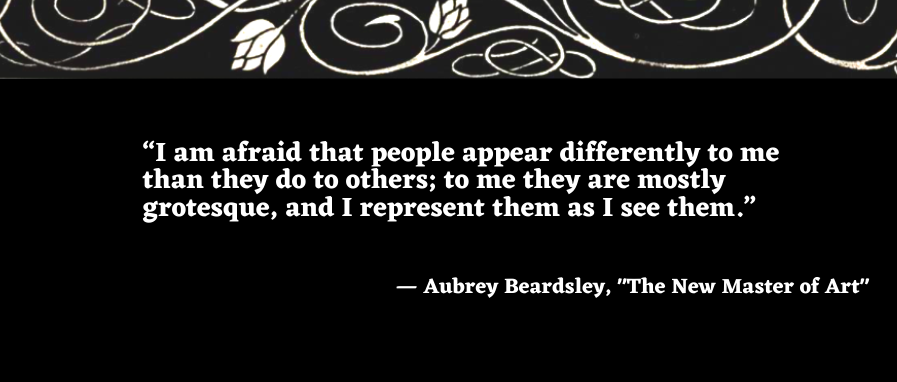
Introduction: Aubrey Beardsley
In an 1894 interview for To-Day, Aubrey Beardsley explained that he saw people differently, more grotesquely, than others (“The New Master of Art”). As the illustrator and artist who came to define the 1890s, Beardsley’s work utilized this “different” perspective to create a vision of society that was incongruous with Victorian ideology. His illustrations, often featuring full nudity, eroticism, and hybridity, challenged contemporary views of sexuality and identity that sought clear and rigid demarcations of categories. When Beardsley turned to writing, he brought this progressive vision with him. His first illustrated novel, The Story of Venus and Tannhäuser, began an exploration of various sexualities and exploits, but was unfortunately left unfinished at the time of his death in 1898 and published posthumously in 1907. While working as the Arts Editor of The Savoy in 1896, Beardsley published the first four chapters of his novel in volumes 1 and 2 of the magazine. Renamed “Under The Hill,” this serialization presents Beardsley’s very progressive views of sexuality through satirical references, subtle hybridity, and gender-blurring.

“Under The Hill” also offers the very important intersection between Beardsley’s artistic imagination and editorial vision, bringing together image, text, and paratext. While it challenges Victorian convention like the majority of his other work, “Under The Hill” is all the more progressive because of its specific placement within The Savoy. Led by Editor Arthur Symons, The Savoy was known for its subversive views of sexuality which foregrounded hierarchical relations between men and women. Because of Beardsley’s different, more radical vision, “Under The Hill” challenges Symons’ editorial direction and resists the dominant discourse of the very magazine in which it finds itself. “Under The Hill,” situated within the context of Victorian society and The Savoy, thus pushes Beardsley into a category of his own.

~ The Beardsley Vision ~

Aubrey Beardsley, as former Co-Editor of The Yellow Book, began work on The Savoy as Arts Editor with a particular editorial vision that was shaped by his views of identity. His work sought to challenge what Victorians believed about themselves when it came to class, power, and sexuality. Throughout the late 1800s, Victorian ideology involved a separation of the domestic sphere, where women were concerned with the household and child-rearing, and the public sphere, where men were the sole bread-winners (Hughes). This division extended to sexuality, presenting sex as a biological imperative that did not necessitate emotional intimacy or sexual satisfaction.
Beardsley entered into this Victorian dialogue in a progressive way. He became concerned with depicting non-hierarchical sexual relations between men and women, often over-sexualizing or satirizing his figures as a way to imbue equality between genders. His focus on free sexual expression, gender blurring, and Decadent excess challenged his readership and undercut notions about what divisions or categories actually meant. According to Chris Snodgrass in his article on “Decadent Mythmaking,” Beardsley “seems to insist on blurring conventional cultural polarities, forcing a multiplicity of self-contradictory readings and implying a world that is anything but univocal” (Snodgrass 75). This attention to multiplicity led to Beardsley’s more subversive form of sexuality: one in which binary ideas are refused and readers are forced to linger in ambiguity. Beardsley’s work offers androgynous figures, men described and appearing as women, and women who take on more masculine roles, especially concerning sex. Beardsley’s views were informed by ambiguity to the point where “the incongruous was a persistent element in his own art” (Schweik 15). Influenced by this vision of sexuality, Beardsley’s editorial vision offers a likewise alternative, hybrid, and very radical way of combining image, text, and paratext to subtly challenge readers and their understanding of clear cut binaries.
~ The Symons Vision ~
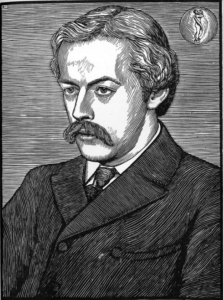
In her article “Aestheticism and Decadence,” Laurel Brake argues that “The Savoy was not confined to a single ‘point of view’” and this is especially true of the magazine’s editorial vision (Brake, “Aestheticism” 94). Arthur Symons’ vision is significantly scaled back in comparison to Beardsley’s. In his Editorial Note for the first volume of The Savoy, Symons writes that the magazine’s aim is to offer “good work” of both literary and artistic mediums “without false unity” (Symons, “Editorial Note” 5). This ambitious goal claims no aesthetic ideology and, while there are a number of styles of writing in The Savoy, Symons’ editorial vision is primarily occupied with Decadence and the avant-garde, lending to a masculine and heteronormative lens. Symons’ focus on excess and sensuality imbues The Savoy with the Decadent tropes of female prostitution, music halls, and material possession that underscores male wealth and power.
According to Kostas Boyipoulos, the Decadent short story was meant to “shock bourgeois morality” and “prop up and scrutinize conflicting cultural and psychological forces” (Boyipoulos 19). However, within Symons’ masculine editorial vision, shocking morality means focusing on sexual relations at all. Where Beardsley seeks hybridity and ambiguity, Symons presents heteronormative sexuality from the conventional male perspective, because “for all his avant-garde sympathies, Symons was a Victorian through and through” (Snodgrass 102). Most of the content in The Savoy feature women as the subject and, while its depiction of sex is progressive in comparison to its Victorian context, Symons’ vision cannot accept contradictions or hybridity; instead, he creates a normative, masculine discourse throughout The Savoy.

The Savoy: Serial Sex
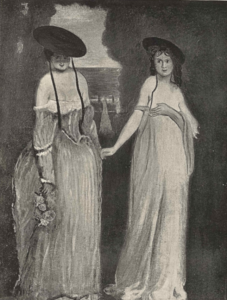
In her chapter on gender in 1896, Laurel Brake argues that “The Savoy is an aggressively male and heterosexual magazine, full of male discourse, masculine constructions of women, and misogyny, bustling…with erotic drawings, and clearly (and exclusively) aimed at male readers” (Brake, “Gender Crisis” 151). This claim accounts for the Decadent and elitist male readership for which The Savoy was published, as well as its very male contributors. Over the course of eight volumes, there are only eight female contributors to The Savoy; within the first two volumes in which “Under The Hill” was published, this number is brought down to only three. This lack of female perspective primed The Savoy for a misogynistic, predatory, and often patriarchal vision that was only further encouraged by the male gaze. In art, this vision is offered in several illustrations which feature women as the sole subject. These artists, like William Rothenstein (Fig. 6), Charles H. Shannon (Fig. 7), and A. Kay Womrath (Fig. 8), often presented women in various stages of undress, gazing away from the viewer so that she can be stared at and objectified.
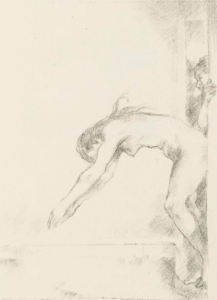
In literature, this vision is found in Symons’ serialization of Lucy Newcome. “Pages From the Life of Lucy Newcome” in volume 1 and “The Childhood of Lucy Newcome” in volume 8 follow the life of a fallen woman who, after her child dies, turns to prostitution. Both of these narratives attempt to retell the story of the real Edith Catherine Broadbent, but the degree of accuracy and its narrative bias remain unknown. Regardless, Symons’ rhetoric is very predatory in both of these stories, and his insistence that “when you are once fallen, you go on falling” only reaffirms the destructive Victorian view of sexuality which judged women for any kind of sexual pleasure (Symons, “Lucy” vol. 1:156). Symons writes of the struggles of a poor, desolate young woman in a very male perspective that denies Lucy nuanced interiority and reveals an agenda of hierarchical gender roles.
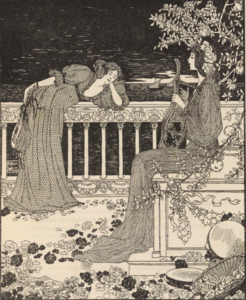
This vision is again prevalent in the serialization of Nancy, the young actress performing in a music hall. Written by Frederick Wedmore, “To Nancy” in volume 1 and “The Deterioration of Nancy” in volume 2 depicts the problematic relationship between a young girl and an older gentleman, who is described supposedly in jest as “your grandfatherly friend” (Wedmore, “Deterioration” vol. 2: 104). Nancy is repeatedly told by said grandfather that she is ruined and aged because of how successful she becomes, once again positioning a woman through the male gaze. The Savoy presents its Decadent stories as though they are subversive because of their implication of sexual promiscuity, but neither Nancy nor Lucy are given characterizations outside of the male perspective. As Anne Margaret Daniel suggests, “only a man with a fetish for just-pubescent music hall girls—like Arthur Symons—could possible enjoy ‘To Nancy,’” thus suggesting that the intended readership of The Savoy excluded women and prioritized men (Daniel 170). Through the majority of its literary and artistic content, The Savoy seems to speak for and about women, presenting them as objects to be looked at and fetishized.
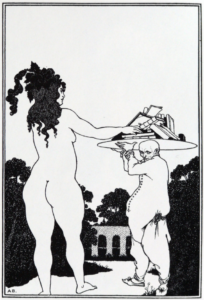
Many have also included Beardsley in this masculine discourse, arguing that his over-sexualized illustrations objectify women in the same vein as the other contributors of The Savoy. Laurel Brake posits that “most nineteenth-century women readers would have found the contents of Symons’, Smithers’, and Beardsley’s venture offensive, and at the very least unrespectable” (Brake, “Gender Crisis” 150). Including Beardsley in The Savoy‘s larger masculine vision (as imagined by Symons and published by Smithers) is, however, unfair to Beardsley’s artistry. While Beardsley did offend many with his overtly grotesque illustrations, he often utilized Decadence as a way to resist the reductive and problematic discourse that rendered women inferior. This vision of identity and class utilized sexuality in connection with power, Decadence, and even education (see: Fig. 9, which was designed by Beardsley for his own bookplate but was later used by Herbert Pollitt) to present an alternative view of women.
As Linda Zatlin argues in her work Aubrey Beardsley and Victorian Sexual Politics, “Beardsley’s brilliance lies in his use of the same sexist motifs to encourage a woman to explore the things which give her pleasure” (Zatlin 118). Through his radical vision of sexuality, evident in “Under The Hill,” Beardsley uses the same masculine gaze consistent with The Savoy but turns it on its head, underlying his work with an editorial vision of ambiguity and hybridity rather than heterosexuality and dominance.

“Under The Hill”
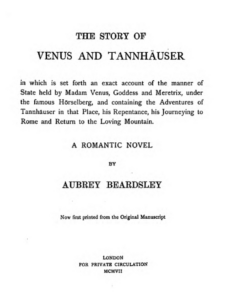

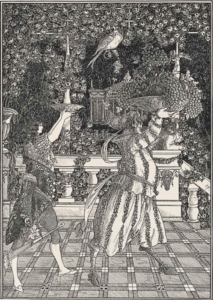
While Beardsley offers dozens of illustrations to The Savoy, nowhere is his editorial vision more prevalent than in “Under The Hill.” This expurgated version of Beardsley’s novel, The Story of Venus and Tannhäuser, retells the legend of Tannhäuser, a knight who visits Venusberg and spends time worshipping the goddess Venus before returning to earth to absolve his sins. This legend, popularized by Richard Wagner’s 1845 opera Tannhäuser, traditionally admonishes Tannhäuser’s sexual acts and exploits with Venus.
However, in his Decadent account of protagonists Abbé Fanfreluche and Helen, Beardsley moves away from traditional kinds of moralizing and towards ambiguity. Most interesting about the two versions of Beardsley’s novel is how different the expurgated version is from the posthumous publication. Though The Story of Venus and Tannhäuser provocatively intwines erotica and near pornography within Decadent narration, the subtlety of “Under The Hill” enriches its prose and illustrations with satirical references, gender blurring, and hybrid paratextuality. If “in not writing of sexual experiences with Venus, the ultimate woman, [Beardsley] achieves a higher art than when he did,” then so too does his editorial decisions in “Under The Hill” achieve a higher status: the perfect playing ground for the Beardsley vision (Trail 22).
i. Satirical References

Beardsley’s primary goal in “Under The Hill” is to tease his content and reader, which he does through a use of satirical references and allusions. Within his Decadent style (see Fig. 11), Beardsley describes characters, settings, and objects to such an excess that he often compares them to obscure cultural references, some of which he fabricates. In volume 1, the pillars leading to Venusberg are equated to “the cool bath-rooms of Cardinal La Motte,” Helen’s beauty is described in context of “the lady in ‘Lemprière,’” and the architecture of her gardens is likened to “the architect of the Fêtes d’Armailhacq” (Beardsley, “Under The Hill” vol. 1: 156, 163, 166). These references are far too unclear and obscure to the general reader, and upon investigation, some are also fictitious. Their inclusion attempts to elevate banal descriptions in service of Decadence but read within the context of ambiguity, these references also invoke distance between the reader and the text. In light of Victorian culture that required clear categories and ideological stances, Beardsley’s references ensure that “Under The Hill” cannot be fully understood.
In volume 2, these references are even more exaggerated. When Fanfreluche awakes the day after meeting Helen, and presumably sleeping with her, he lies in bed and thinks of “Romaunt de la Rose,” of “Claude in Lady Delaware’s collection,” and of “Racine’s ‘Britannicus’” (Beardsley, “Under The Hill” vol. 2: 187, 188). Beardsley does not offer any explanation of what these references are or how they are meaningful to Fanfreluche and instead satirizes them, offering ambiguity that pushes against rigidity and renders the text all the more suggestive.
Sometimes, Beardsley offers an illustration for references, like “Saint Rose” who is depicted in the image “The Ascension of Saint Rose of Lima” (Fig. 13) and “the score of ‘The Rheingold’” which is illustrated in “For The Third Tableau of ‘Das Rheingold’” (Fig. 14) (Beardsley “Under The Hill” vol. 2: 187, 192). While these visuals ground some of the more obscure references, they still alienate readership by highlighting the readers’ lack of knowledge of these very specific religious figures and musical productions. As well, these illustrations and their mysticism seem to resist the logical rationale which was inherent in the Victorian reader, offering a couple floating above earth in Fig. 13 and an androgynous figure taming a large snake in Fig. 14.
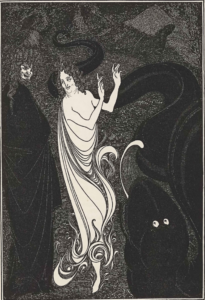
By creating ambiguity in both these images and text, Beardsley teases his reader and “gives satiric expression to this complex yearning within fin de siècle Decadence for both sexual innocence and sexual expressiveness” (Dowling 32). Beardsley’s obscure references are simultaneously illustrated with specific detail and this decision transforms his hybrid sexual vision into a hybrid editorial vision that resists conclusive meaning.
This is further established in Beardsley’s use of the French language in his references. Throughout “Under The Hill” Beardsley invokes terms like “coiffeur,” “frôler,” and “consommé impromptu” to enhance his Decadent descriptions and hint at eroticism (Beardsley, “Under The Hill” vol. 1: 160, 164, 169). This veiled elegance plays upon the exoticism and suggestiveness of France, whose reputation of pornography was well-known during the Victorian era. In her article “Unfamiliar Places,” Jennifer Higgins argues that “Beardsley thus draws on this double association of the French language, simultaneously obscene and exclusive” and in doing so, instills a further degree of ambiguity into “Under The Hill” (Higgins 82). Because the non-French reader must guess at the definition of these terms, just like the obscure references, Beardsley teases meaning without delivering a definitive answer. This playful feature, which Symons explains as Beardsley’s “whole conception of writing…[as] a game with words,” situates “Under The Hill” in ambiguity that resists any clear moralizing from Beardsley—who is at once author, illustrator, and editor (Symons, “The Art,” np). As such, “Under The Hill” becomes inaccessible to the reader and in opposition of the rest of The Savoy.
ii. Gender Blurring
Beardsley’s ambiguity extends to the gender blurring of “Under The Hill,” where the characters Abbé Fanfreluche and Helen are introduced not in personality or behaviour but in physicality. Much attention is given to Fanfreluche’s appearance, which is often described in female terms: his travel is qualified in how it has “undone the laboured niceness of his dress,” his hands are as “slim and gracious as La Marquise,” and his sleep attire is a “dainty night-dress” (Beardsley, “Under The Hill” vol. 1: 156, vol. 2: 195). Through this language, Beardsley blurs the gender of his male protagonist so that he is not portrayed as conventionally masculine. Even Fanfreluche’s name, translated from the French, means “frills” or “lace,” both of which connote female clothing and ornamentation. This very specific choice of name for a male hero demonstrates Beardsley’s dedication to the editorial vision of hybridity, whilst also revealing, as Snodgrass suggests, how “Beardsley goes out of his way to…confuse the viewer, blurring conventional gender and cultural distinctions well beyond the strict requirements of the joke” (Snodgrass 75).
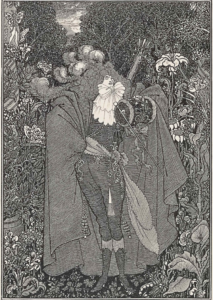
Beardsley’s playful decisions throughout “Under The Hill” also demonstrate how his hybridity of theme becomes a hybridity of medium. Much of what Beardsley describes in the chapters intertextually refer to various illustrations present in “Under The Hill.” Unlike other works throughout the rest of The Savoy, these images are embedded within the text rather than occurring at the end or at the beginning. This hybrid placement is important because it draws out Beardsley’s erotic coding within the chapters. Boyiopoulos explains that in Decadent narratives from the 1890s “fragmented or expurgated texts could infer illicit content that is not technically present in the story” (Boyiopoulos 6). Since “Under The Hill” is the expurgated version of the very pornographic Story of Venus and Tannhäuser, Beardsley relies on the illustrations to relay the more nefarious and provocative content he was known for. This erotic coding, what Higgins calls “Beardsley’s visual language,” is another feature of Beardsley’s editorial vision which confuses readers and challenges their thinking (Higgins 73).
The gender blurring of Fanfreluche is therefore made all the more effective and subversive because of its presence not only in text, but also in illustration. The image of Fanfreluche (Fig. 15) is placed opposite the textual introduction of the male hero, presenting him with Decadent detail, a dramatic curvature of his hips, large curly hair, elaborate clothing, and an environment of flowers and butterflies—all of which portray a male figure that is not stereotypically heteronormative or masculine. Viewing this image in conjunction with its respective text thus erotically codes Beardsley’s work in a very suggestive way.
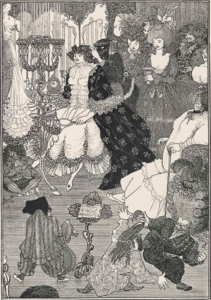
Beardsley also blurs gender when he challenges the concept of femininity in Helen, his female protagonist. Where Fanfreluche is described in isolation, Helen’s appearance is depicted in relation to her staff. Her grooming, an excessive affair that requires assistance from several individuals, creates a dynamic that imbues Helen with power and authority. Beardsley also gives her more personality than her male counterpart, describing her relationship with Mrs. Marsuple, with whom she has “a perfect understanding giving to scraps of phrases their full meaning, and to the merest reference a point” (Beardsley, “Under The Hill” vol.1: 163). This cheeky observation of their ambiguous communication (much like the relationship between Beardsley and his readers) reflects Helen’s importance and intelligence. Simultaneously, this illustration of Helen (Fig. 16), which is likewise placed opposite her introduction, purposefully exposes her breasts and reveals her power as much as her sexuality. Zatlin writes that in this image of Helen, “Beardsley combine[s] emblems and motifs of the verbal and visual traditions of pornography to challenge that tradition which denigrated and abused women” (Zatlin 121). Helen’s exposure is not used for pornographic aims but for subversion, and in this way, Beardsley blurs traditional gender roles. Unlike Symons and Wedmore, who describe their female subjects through power relations, Beardsley flips this hierarchy and showcases a woman who is powerful and sexually independent.
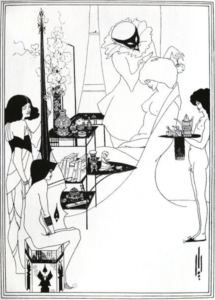
Interestingly, this image is very similar to Beardsley’s illustration of “The Toilette of Salome,” which he contributed to the English edition of Oscar Wilde‘s Salome in 1894. In this illustration (Fig. 17), the woman at the centre has her hands in her lap, suggesting self-pleasure, and is watched by several figures. This explicit position gives the woman power over her own pleasure and sexuality, opposing the reduction of female sexuality to reproduction and so offending the Victorian viewer. As Zatlin explains, these instances of Beardsley’s artwork are “shocking because of her partial nudity and her failure to conform to the idea that women should enjoy the ‘benefits’ of the position of inferiority” (Zatlin 87). Because this image is published before “Under The Hill,” it becomes a reference for Beardsley’s visual language where hidden hands denote self pleasure. Helen’s introduction (Fig. 17) therefore becomes an expurgated and very subtle version of this same image from Salome, both of which, regardless of their degree of explicit content, challenge the view of women as a passive, “fallen” object that is repeatedly depicted throughout The Savoy (see: Fig. 6, 7, 8).

iii. Paratext

Outside of text and images, Beardsley’s editorial vision also incorporates a lot of paratext. In volume 1, “Under The Hill” is introduced by a title page which identifies chapters one to three as “A Romantic Novel” (Fig. 12). This page is uncharacteristically devoid of any design or imagery, instead presenting its contents almost plainly. Flipping past this title, the chapters are again delayed by another paratextual introduction: Beardsley includes a formally written, three page letter addressed to “Giulio Poldo Pezzoli.” This addressee, who over the course of almost half a page, is qualified as a “Reverend Prince,” “Cardinal of the Roman Church,” “Bishop of S. Maria,” and “Archbishop” among several other titles, may at first appear as a real and necessary figure to whom Beardsley pays tribute (Beardsley, “Under The Hill” vol. 1:153). However, as the letter goes on to excessively admire this Prince and ask for his attention, Beardsley satirizes the very legend with whom he enters a dialogue, ironically poking fun at the myth of Tannhäuser and its religious undertones. Beardsley preemptively apologizes for his writing, “for which extravagance let my youth excuse me,” and in this paratextual letter, signals to the reader that the work which follows is not to be taken at face value (Beardsley, “Under The Hill” vol.1: 154). The inclusion of these typically literary features within a periodical further establishes the hybridity of “Under The Hill,” making it at once neither fully a novel nor fully a short story.

Beardsley is also self-referential in the introduction of “Under The Hill” in volume 2. In lieu of another title page, Beardsley includes the illustration “A Footnote” (Fig.19) which leads the reader into chapter 4 of “Under The Hill.” This pen and ink drawing features an androgynous-looking man—supposedly a self-portrait of Beardsley—whose feet are tied together to a post that is fashioned with the torso of a satyr. There are several references to satyrs in the first three chapters of “Under The Hill,” but in this illustration, Beardsley’s bondage to the mythological figure of sexuality and passion asks its viewer to confront the queerness of the subject. Beardsley is not only attached to this symbol of sexual pleasure, but he also is the symbol of pleasure. By revealing his connection to sex, and the subsequent irony of this implication (as hinted in his devious smirk), Beardsley continues the playful joke he began with the satirical references.
In the fourth chapter of “Under The Hill,” the meaning of “A Footnote” becomes twofold. In an attempt either to engage his reader or further alienate them, Beardsley punctuates several obscure references with footnotes that offer more information and context. These footnotes, like the one for the comedy ballet “Bacchanals of Sporion,” are not contained within a single section but span several pages, often taking up more space than the actual narrative (Beardsley, “Under The Hill vol. 2: 188–192). That Beardsley goes as far as to include an entire one act of a ballet in the footnotes reveals how he delivers his editorial vision to the extreme and questions the importance of conventional methods of print. The reader, confronted by two opposing narratives—one in the text of the chapters and the other in the text of the footnotes—is therefore confronted with Beardsley’s hybrid editorial vision. “A Footnote,” taken without any context, seems to situate Beardsley within sexual deviation, but within the context of “Under The Hill” and The Savoy, this image becomes the perfect example of Beardsley’s radical thinking.
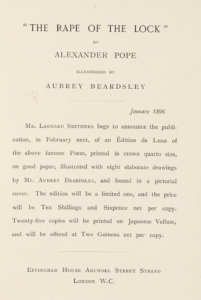
Such paratext is once again intertwined into “Under The Hill,” where after only a page of prose in its first chapter, the narrative is again interrupted by an advertisement and order form for a special edition of Alexander Pope’s “The Rape of The Lock” illustrated by Beardsley. Of the near 200 pages in which to include an advertisement for another of Beardsley’s work, the placement of this addendum is interesting. Just like the title page, introductory letter, and footnotes, the order form and advertisement seem to undermine the significance of Beardsley’s literary work. Volume 1 and 2 of The Savoy continuously interrupt the natural reading flow of “Under The Hill” and make it appear almost like an advertisement itself. According to Koenraad Claes, “the ambiguous nature of such very particular paratextual addenda is highly problematic, as they simultaneously are and are not part of the periodical they are supplementing” (Claes 12). “Under The Hill” seems to be in-and-of-itself a paratextual addenda, especially given its location at the very end of both volumes of The Savoy. This particular placement draws attention to “Under The Hill” not only because it closes the volume, but also because readers would need to flip through the rest of its contents in order to read what might be their allure to buy the volume in the first place. In her analysis of “Arthur Symons and The Savoy,” Anne Margaret Daniel suggests that this consumerism aspect is the exact reason for the placement of “Under The Hill” noting that “The Savoy would have died a far quicker death but for “Under The Hill.” Beardsley’s art and prose sold The Savoy because they, and he, were considered shocking, and Symons knew this and—despite his written disclaimers about decadence—used Beardsley to great effect” (Daniel 175). Whether or not Symons actually did use Beardsley, it is clear that “Under The Hill” undermines Symons’ editing system by disrupting the rest of The Savoy and giving readers an end that seems wholly in opposition to Symons’ masculine, rigid, and normative editorial vision.
This juxtaposition, while important for Beardsley as an independent creator, may actually have had consequences for The Savoy. If paratextual elements are and are not a part of the periodical they supplement, then maybe “Under The Hill” both is and is not a part of The Savoy.
A Category of His Own?
“The world of Beardsley’s pictures seems always to suggest that decadence may merely explore the unsettling possibility that life is at its very core undecidably ambiguous, merely an endless paradox of vexing and finally irresolvable self-contradictions. It was a vision Symons was willing to ponder intermittently…but for the most part it was precisely the kind of view of life—and of the Decadence— which he could not allow himself to embrace” (Snodgrass 102).

So then where does that leave The Savoy, if its Editor and Arts Editor were at visionary odds? Claes suggests that The Savoy did not live up to the aim of offering art ‘without false unity’ because it “appears…to consciously reject the Total Work of Art aesthetic” which was found in most little magazines (Claes 137). As Arts Editor, Beardsley took the liberty to express his radical views and progressive thinking against the need for a cohesive periodical. “Under The Hill” offers the most enriched—if incomplete and fragmented—example of the Beardsley editorial vision which sought to publish ambiguity, hybridity and playful satire, even when it was in opposition to a more normative vision of Decadence, masculinity, and the avant-garde.
Though The Savoy was very much Symons’ and Beardsley’s shared publication, by the time its first volume was published, Beardsley was already ahead of it. His ambitious contributions (and their polarizing reception) deemed Beardsley the star of The Savoy, even when, and especially after, Beardsley died in 1898. “Under The Hill” is and is not part of The Savoy in the same way that Beardsley was and was not considered a master of art. If, by presenting two very different editorial visions, The Savoy does not fully abide by the Total Work of Art aesthetic, then it does so because Beardsley’s artistry could not be accommodated by mere ephemera or miscellany. Beardsley’s scope was simply too revolutionary for a single magazine to contain.
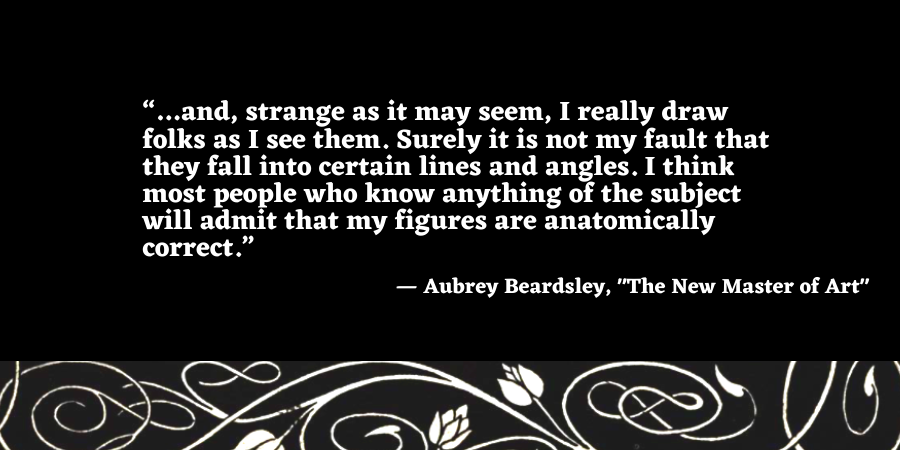
Works Cited
“Aubrey Beardsley.” WikiArt: Visual Art Encylopedia. (Fig. 1, 2, 3, 9, 17, 21). https://www.wikiart.org/en/aubrey-beardsley.
Beardsley, Aubrey. “A Footnote.” The Savoy, vol. 2, April 1896, pp. 185. The Savoy Digital Edition, edited by Christopher Keep and Lorraine Janzen Kooistra 2018-2019. Yellow Nineties 2.0, Ryerson University Centre for Digital Humanities, 2019, https://1890s.ca/savoyv2_beardsley_footnote/
—. “For the Third Tableau of Das Rheingold.” The Savoy, vol. 2, April 1896, pp. 193. The Savoy Digital Edition, edited by Christopher Keep and Lorraine Janzen Kooistra 2018-2019. Yellow Nineties 2.0, Ryerson University Centre for Digital Humanities, 2019, https://1890s.ca/savoyv2_beardsley_rheingold/
—. “The Abbé.” The Savoy, vol. 1, January 1896, pp. 157. The Savoy Digital Edition, edited by Christopher Keep and Lorraine Janzen Kooistra, 2018-2019. Yellow Nineties 2.0, Ryerson University Centre for Digital Humanities, 2019, https://1890s.ca/savoyv1_beardsley_abbe/
—. “The Ascension of Saint Rose of Lima.” The Savoy, vol. 2, April 1896, pp. 189. The Savoy Digital Edition, edited by Christopher Keep and Lorraine Janzen Kooistra 2018-2019. Yellow Nineties 2.0, Ryerson University Centre for Digital Humanities, 2019, https://1890s.ca/savoyv2_beardsley_ascension/
— “The Fruit-Bearers.” The Savoy, vol. 1, January 1896, pp. 167. The Savoy Digital Edition, edited by Christopher Keep and Lorraine Janzen Kooistra, 2018-2019. Yellow Nineties 2.0, Ryerson University Centre for Digital Humanities, 2019, https://1890s.ca/savoyv1_beardsley_fruit/
—. The Story of Venus and Tannhäuser. Leonard Smithers, 1907, Project Gutenberg, https://www.gutenberg.org/files/50210/50210-h/50210-h.htm
—. “The Toilet.” The Savoy, vol. 1, January 1896, pp. 161. The Savoy Digital Edition, edited by Christopher Keep and Lorraine Janzen Kooistra 2018-2019. Yellow Nineties 2.0, Ryerson University Centre for Digital Humanities, 2019, https://1890s.ca/savoyv1_beardsley_toilet/
—. “Under the Hill.” The Savoy, vol. 1 January 1896, pp. 151-170. The Savoy Digital Edition, edited by Christopher Keep and Lorraine Janzen Kooistra, 2018-2020. Yellow Nineties 2.0, Ryerson University Centre for Digital Humanities, 2019. https://1890s.ca/savoyv1-beardsley-hill/
—. “Under the Hill.” The Savoy, vol. 2, April 1896, pp. 187-196. Savoy Digital Edition, edited by Christopher Keep and Lorraine Janzen Kooistra, 2018-2020. Yellow Nineties 2.0, Ryerson University Centre for Digital Humanities, 2019. https://1890s.ca/savoyv2-beardsley-hill/
Boyiopoulos, Kostas, Yoonjoung Choi, Matthew Brinton Tidesley, editors. “Introduction.” The Decadent Short Story: An Annotated Anthology, Edinburgh University Press, 2014, pp. 1-24.
Brake, Laurel. “The Savoy: 1896. Gender in Crisis?” Subjugated Knowledges: Journalism, Gender, and Literature in the 19th Century, New York University Press, 1994, pp. 148-165.
—. “Aestheticism and Decadence: The Yellow Book (1894-7), The Chameleon (1896), and The Savoy (1896).” The Oxford Critical and Cultural History of Modernist Magazines: Volume I: Britain and Ireland 1880-1955, 2013, Oxford Scholarship Online, np. DOI: 10.1093/acprof:osobl/9780199654291.001.0001.
Claes, Koenraad. The Late-Victorian Little Magazine. Edinburgh University Press, 2017.
Daniel, Anne Margaret. “Arthur Symons and The Savoy.” Literary Imagination: The Review of the Association of Literary Scholars and Critics, vol. 7, no. 2, 2005, pp. 165-193.
Dowling, Linda C. “Venus and Tannhäuser: Beardsley’s Satire of Decadence.” The Journal of Narrative Technique, vol. 8, no. 1, 1978, pp. 26-41. JSTOR, www.jstor.org/stable/30225628.
Harpham, Geoffrey. “The Incompleteness of Beardsley’s Venus and Tannhäuser.” English Literature in Transition, 1880-1920, vol. 18, no. 1, 1975, pp. 24-32.
Higgins, Jennifer. “Unfamiliar Places: France and the Grotesque in Aubrey Beardsley’s Poetry and Prose.” The Modern Language Review, vol. 106, no. 1, 2011, pp. 63-85. JSTOR, www.jstor.org/stable/10.5699/modelangrevi.106.1.0063.
Hughes, Kathryn. “Gender Roles in the 19th century.” The British Library: Romantics & Victorians. 15 May 2014. https://www.bl.uk/romantics-and-victorians/articles/gender-roles-in-the-19th-century.
Rothenstein, William. “Two Ladies.” The Savoy, vol. 2, April 1896, pp. 165. The Savoy Digital Edition, edited by Christopher Keep and Lorraine Janzen Kooistra 2018-2019. Yellow Nineties 2.0, Ryerson University Centre for Digital Humanities, 2019, https://1890s.ca/savoyv2_rothenstein_ladies/
Schweik, Robert. “Congruous Incongruities: The Wilde-Beardsley “Collaboration.”” English Literature in Transition, 1880-1920, vol. 37 no. 1, 1994, pp. 9-26. Project MUSE, muse.jhu.edu/article/373621.
Shannon, Charles H. “The Dive.” The Savoy, vol. 2, April 1896, pp. 137. The Savoy Digital Edition, edited by Christopher Keep and Lorraine Janzen Kooistra 2018-2019. Yellow Nineties 2.0, Ryerson University Centre for Digital Humanities, 2019, https://1890s.ca/savoyv2_shannon_dive/
Snodgrass, Chris. “Decadent Mythmaking: Arthur Symons on Aubrey Beardsley and Salome.” Victorian Poetry, vol. 28, no. 3/4, 1990, pp. 61-109. JSTOR, www.jstor.org/stable/40002291.
Symons, Arthur. “Editorial Note.” The Savoy, vol. 1 January 1896, pp. 5. Savoy Digital Edition, edited by Christopher Keep and Lorraine Janzen Kooistra, 2018-2020. Yellow Nineties 2.0, Ryerson University Centre for Digital Humanities, 2019. https://1890s.ca/savoyv1-symons-editorial/
—. “Pages from the Life of Lucy Newcome.” The Savoy, vol. 2, April 1896, pp. 147-160. Savoy Digital Edition, edited by Christopher Keep and Lorraine Janzen Kooistra, 2018-2020. Yellow Nineties 2.0, Ryerson University Centre for Digital Humanities, 2019. https://1890s.ca/savoyv2-symons-lucy/
—. The Art of Aubrey Beardsley. Boni and Liveright, Inc, 1918. Project Gutenberg, http://www.gutenberg.org/files/50171/50171-h/50171-h.htm.
—. “The Childhood of Lucy Newcome.” The Savoy vol. 8, December 1896, pp. 51-61. Savoy Digital Edition, edited by Christopher Keep and Lorraine Janzen Kooistra, 2018-2020. Yellow Nineties 2.0, Ryerson University Centre for Digital Humanities, 2019. https://1890s.ca/savoyv8-symons-childhood/
“The New Master of Art. Mr. Aubrey Beardsley.” To-Day, 12 May 1894, pp. 28-29.
Trail, George Y. “Beardsley’s Venus and Tannhäuser: Two Versions.” English Literature in Transition, 1880-1920, vol. 18 no. 1, 1975, pp. 16-23. Project MUSE, muse.jhu.edu/article374578.
Wedmore, Frederick. “The Deterioration of Nancy.” The Savoy, vol. 2 April 1896, pp. 99-108. Savoy Digital Edition, edited by Christopher Keep and Lorraine Janzen Kooistra, 2018-2020. Yellow Nineties 2.0, Ryerson University Centre for Digital Humanities, 2019. https://1890s.ca/savoyv2-wedmore-deterioration/
—. “To Nancy.” The Savoy, vol. 1 January 1896, pp. 31-41. Savoy Digital Edition, edited by Christopher Keep and Lorraine Janzen Kooistra, 2018-2020. Yellow Nineties 2.0, Ryerson University Centre for Digital Humanities, 2019. https://1890s.ca/savoyv1-wedmore-to-nancy/
Womrath, A. Kay. “Le Chanson [The Song].” The Savoy, vol. 5, September 1896, pp. 9. The Savoy Digital Edition, edited by Christopher Keep and Lorraine Janzen Kooistra 2018-2019. Yellow Nineties 2.0, Ryerson University Centre for Digital Humanities, 2019, https://1890s.ca/savoyv5_womrath_chanson/
Zatlin, Linda. Aubrey Beardsley and Victorian Sexual Politics. Clarendon Press, 1990.
NOTE: Images in this online exhibit are either in the public domain or being used under fair dealing for the purpose of research and are provided solely for the purposes of research, private study, or education.

